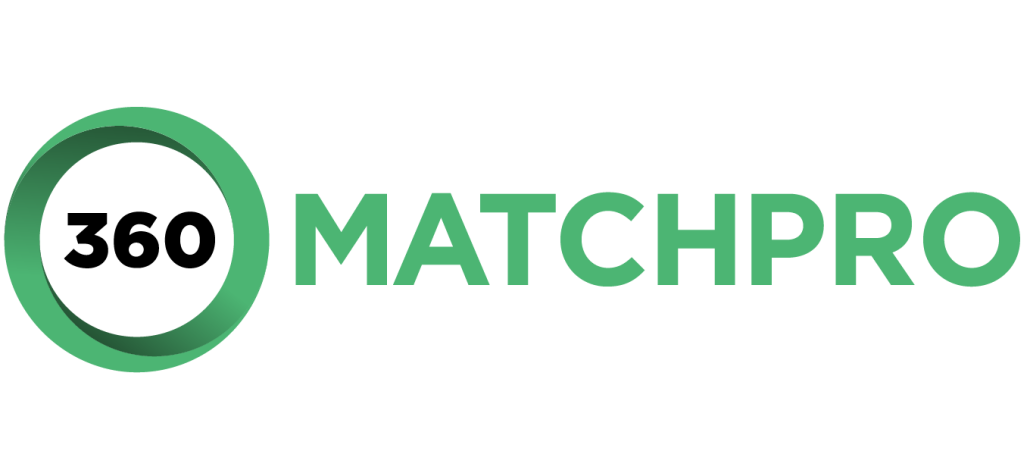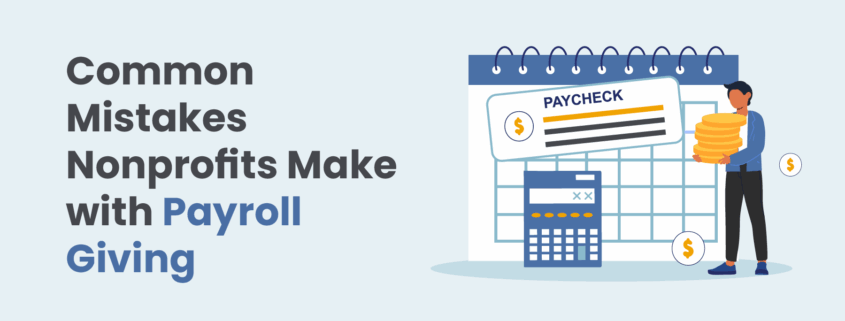Common Mistakes Nonprofits Make with Payroll Giving
Payroll giving programs can be a powerful tool for nonprofits, enabling employees to contribute directly to charitable causes through automatic deductions from their salaries. However, many organizations encounter pitfalls that hinder the effectiveness of these initiatives. In this article, we will explore the common mistakes nonprofits make with payroll giving and provide actionable strategies to enhance these programs. By understanding these challenges, nonprofits can optimize their payroll giving efforts and maximize donor engagement.
Payroll giving programs are a powerful and reliable tool for nonprofits, allowing employees to contribute directly to charitable causes through automatic salary deductions. However, many nonprofits encounter pitfalls that can undermine the effectiveness of payroll giving programs.
In this article, we’ll explore the common mistakes nonprofits make when managing payroll giving and provide actionable strategies to enhance these programs:
- Limited Employee Awareness
- Insufficient Promotion by Nonprofits
- Administrative Delays
- Lack of Donor Engagement
- Mismanagement of Restricted Funds
- Inadequate Internal Controls
- Overlooking Matching Gifts
By addressing these challenges, nonprofits can optimize payroll giving efforts, strengthen donor engagement, and maximize the impact of their fundraising initiatives. Let’s begin!
Mistake #1: Limited Employee Awareness
One of the most common barriers to effective payroll giving is limited employee awareness. Many employees may not even be aware that their company offers payroll giving programs, resulting in underutilization of this valuable fundraising tool. When employees are unaware of their ability to contribute to charitable causes through payroll deductions, organizations miss out on potential donors. This lack of awareness also means that employees who might be willing to contribute simply don’t have the necessary information to get involved.
Strategies to Increase Awareness
To combat this issue, nonprofits should work with employers to actively promote payroll giving initiatives. Effective strategies include:
-
Internal Communications: Utilize newsletters, social media, and your own website to spread the word about payroll giving programs. Inform employees about the ease of contributing through payroll deductions and the positive impact their contributions will have on the nonprofit’s mission.
-
Engaging Content: Create content that engages employees and highlights the tangible impact of payroll giving. For example, share stories of individuals whose lives were changed thanks to the nonprofit’s programs, or provide updates on projects funded through employee donations.
-
Incentives: To encourage participation, consider offering incentives for employees who sign up for payroll giving. Recognizing contributors with shout-outs, small rewards, or special recognition can create a sense of community and encourage others to get involved.
By effectively raising awareness and engaging employees, nonprofits can increase participation and make payroll giving a more integral part of their fundraising efforts.
Mistake #2: Insufficient Promotion by Nonprofits
Another critical mistake is the insufficient promotion of payroll giving programs by nonprofits themselves. While nonprofits may promote traditional fundraising methods, they often overlook the value and ease of payroll giving. This oversight can lead to missed opportunities, particularly when employees are unaware of the program or don’t see it as a priority.
Enhancing Promotion Efforts
To boost engagement and participation, nonprofits should market payroll giving opportunities by:
-
Creating a Dedicated Page: Design a dedicated payroll giving page on the nonprofit’s website that provides clear instructions on how to sign up, the benefits of participation, and how donations will be used to support the mission. Include a call to action that encourages immediate sign-up.
-
Incorporating Regular Messaging: Incorporate payroll giving messaging into all nonprofit communications, including email newsletters, social media updates, and direct outreach. Regular reminders about the program keep it top of mind and reinforce its importance to your cause.
-
Sharing Success Stories: Share real-life success stories that illustrate how payroll donations have made a tangible impact. By highlighting the positive change driven by employee contributions, nonprofits can inspire greater participation.
When nonprofits invest time and effort into promoting payroll giving, they create a stronger connection with their supporters and encourage greater long-term engagement.
Mistake #3: Administrative Delays
Administrative delays are another common issue in payroll giving programs. Because multiple parties (employers, payroll agencies, and nonprofit organizations) are often involved in processing donations, there can be delays in the timely collection and distribution of funds. These delays can lead to frustration among donors, who may feel disconnected from their contributions, and can also hinder the nonprofit’s ability to accurately track and report donations.
Streamlining Administrative Processes
To minimize administrative delays and ensure smooth operations, nonprofits should:
-
Establish Efficient Systems: Work with employers and payroll service providers to create clear, efficient systems for monitoring and tracking payroll donations. Establish a process that ensures the timely processing and distribution of funds.
-
Regular Monitoring: Regularly track donations and verify that the funds are being properly processed. By identifying and addressing any issues promptly, nonprofits can ensure that donors’ contributions are accurately reflected in their records.
-
Clear Communication: Maintain open lines of communication with employers and payroll agencies to clarify donation processing timelines and expectations. This ensures everyone involved understands their responsibilities and that there are no surprises when it comes to fund distribution.
Streamlining administrative processes enhances the donor experience, reduces errors, and increases overall program efficiency, ultimately strengthening the nonprofit’s payroll giving efforts.
Mistake #4: Lack of Donor Engagement
Although payroll giving is an automatic process, a lack of donor engagement can lead to lower retention rates and reduced support over time. Because contributions are made through payroll deductions, donors may feel disconnected from the cause and less invested in the impact of their donations. This disengagement can undermine the long-term sustainability of payroll giving programs and reduce the likelihood that donors will continue to contribute.
Top Tips to Enhance Engagement with Donors
To deepen engagement and strengthen relationships with payroll giving donors, nonprofits should provide opportunities for:
-
Regular Updates: Provide regular updates to payroll donors, sharing how their contributions are being used to support the nonprofit’s mission. This can include specific examples of programs funded by payroll giving or updates on progress toward fundraising goals.
-
Personalized Communication: Send personalized thank-you notes or emails to payroll donors to express gratitude for their ongoing support. Acknowledging donors and showing appreciation fosters a sense of connection and encourages continued participation.
-
Engagement Events: Organize exclusive events or webinars for payroll donors to showcase the impact of their contributions. Inviting donors to virtual meetups or special presentations allows them to feel more connected to the nonprofit’s work.
By engaging payroll donors and keeping them informed, nonprofits can cultivate long-term relationships and increase donor loyalty.
Mistake #5: Mismanagement of Restricted Funds
Mismanagement of restricted funds is a significant risk for nonprofits using payroll giving programs, especially when donations are designated for specific purposes. Failing to properly track and allocate restricted funds can result in compliance issues, miscommunication, and reduced donor trust. Donors expect that their contributions will be used as intended, and nonprofits must maintain clear records to ensure this happens.
Implementing Effective Fund Management
To manage restricted funds properly, nonprofits should:
-
Fund Accounting Software: Use fund accounting software to accurately track both restricted and unrestricted funds. This allows nonprofits to separate and manage donations designated for specific programs or purposes.
-
Documentation: Ensure that all donations, particularly restricted funds, are carefully documented and tracked. This includes keeping records of how funds are spent and ensuring they align with the donor’s wishes.
-
Regular Audits: Conduct regular internal audits to ensure that restricted funds are being used appropriately. Audits help identify any discrepancies and provide an opportunity to correct them before they become larger issues.
By effectively managing restricted funds, nonprofits maintain donor trust and compliance, ultimately fostering a positive and transparent relationship with supporters.
Mistake #6: Inadequate Internal Controls
Weak or insufficient internal controls can lead to errors, fraud, and financial mismanagement in payroll giving programs. Without strong policies in place, nonprofits risk misallocating funds, losing track of donations, or facing compliance challenges that could damage their reputation and operations.
Strengthening Internal Controls
To enhance internal controls and safeguard payroll donations, nonprofits should:
-
Clear Financial Policies: Create clear, detailed financial policies that outline how payroll donations will be processed, recorded, and allocated. These policies should provide guidance for handling all aspects of payroll giving, from donor registration to fund distribution.
-
Segregation of Duties: Implement a system of segregation of duties to prevent conflicts of interest and ensure that no single individual has control over all aspects of payroll giving. This helps reduce the risk of errors or fraudulent activity.
-
Training: Provide regular training for staff members on financial management best practices and compliance requirements. This ensures everyone involved in the process understands their role and the importance of maintaining accurate records and following proper procedures.
Strengthening internal controls minimizes risk and ensures the nonprofit’s payroll giving program runs smoothly and efficiently.
Mistake #7: Overlooking Matching Gifts
Finally, overlooking matching gifts is a common missed opportunity in payroll giving programs. Many companies offer matching gift programs that allow employees to double or even triple their contributions. By not actively promoting and tracking matching gifts, nonprofits miss the chance to maximize the impact of payroll donations.
Maximizing Matching Gift Opportunities
To take full advantage of matching gifts, nonprofits should:
-
Educate Donors: Actively educate donors about the availability of matching gift programs and how they can easily submit requests. Many donors are unaware of these programs or how to access them, so providing clear instructions is crucial.
-
Provide Assistance: Make the process of submitting matching gift requests as simple as possible by offering assistance and resources. Providing pre-filled forms or offering to submit the request on behalf of donors can help streamline the process.
-
Highlight Impact: Use communications to emphasize the additional impact matching gifts have on your nonprofit’s efforts. Show donors how their contribution is being maximized through their company’s matching gift program.
By leveraging matching gift programs alongside payroll giving programs, nonprofits can significantly increase the total funds raised through payroll giving alone.
Conclusion
Payroll giving programs present a unique opportunity for nonprofits to secure consistent, long-term support from employees. By addressing the common mistakes and implementing best practices, nonprofits can optimize their payroll giving efforts and strengthen donor engagement.
Whether it’s increasing employee awareness, managing restricted funds, or maximizing matching gift opportunities, a strategic approach to payroll giving can help organizations unlock their full potential. With a proactive and well-managed program, nonprofits can build lasting relationships with donors and ensure sustainable growth for years to come.
Explore Double the Donation’s Payroll Giving Tools
Ready to unlock the full potential of payroll giving for your nonprofit? Explore Double the Donation’s powerful payroll giving tools to easily identify eligible supporters and boost your fundraising efforts. Our platform helps you connect with the right donors, streamline the process, and raise more through workplace giving programs. Request a demo today and see the tools in action!



